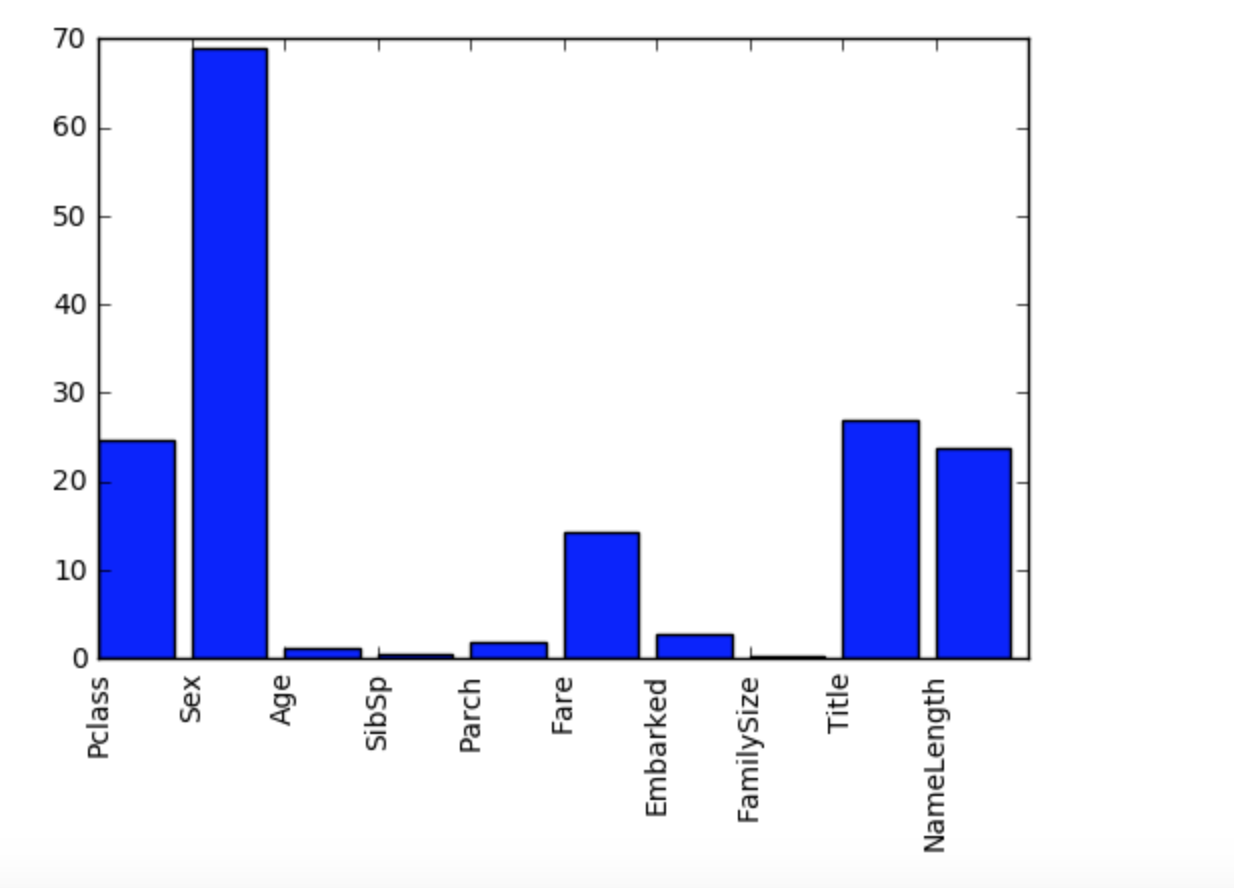【问题描述】
注意:本案例来自于唐宇迪机器学习教程
根据泰坦尼克号乘客信息,构建机器学习模型,预测样本数据是否获救。由于是二分类问题,所以可以采用多种机器学习模型来进行数据拟合以及分类。
涉及内容
- 数据预处理
- 数据空值
- 离散型数值转数字
- 数据拼接
- 随机森林算法
- 逻辑回归算法
- 线性回归算法
- 交叉验证
- 随机森林属性权重选择
- 正则表达式
数据集以及源码
import pandas #ipython notebook
titanic = pandas.read_csv("titanic_train.csv")
titanic.head(5)
#print (titanic.describe())
titanic["Age"] = titanic["Age"].fillna(titanic["Age"].median())
titanic.describe()
print(titanic["Sex"].unique())
# Replace all the occurences of male with the number 0.
titanic.loc[titanic["Sex"] == "male", "Sex"] = 0
titanic.loc[titanic["Sex"] == "female", "Sex"] = 1
print(titanic["Embarked"].unique())
titanic["Embarked"] = titanic["Embarked"].fillna('S')
titanic.loc[titanic["Embarked"] == "S", "Embarked"] = 0
titanic.loc[titanic["Embarked"] == "C", "Embarked"] = 1
titanic.loc[titanic["Embarked"] == "Q", "Embarked"] = 2
# Import the linear regression class
from sklearn.linear_model import LinearRegression
# Sklearn also has a helper that makes it easy to do cross validation
from sklearn.cross_validation import KFold
# The columns we'll use to predict the target
predictors = ["Pclass", "Sex", "Age", "SibSp", "Parch", "Fare", "Embarked"]
# Initialize our algorithm class
alg = LinearRegression()
# Generate cross validation folds for the titanic dataset. It return the row indices corresponding to train and test.
# We set random_state to ensure we get the same splits every time we run this.
kf = KFold(titanic.shape[0], n_folds=3, random_state=1)
predictions = []
for train, test in kf:
# The predictors we're using the train the algorithm. Note how we only take the rows in the train folds.
train_predictors = (titanic[predictors].iloc[train,:])
# The target we're using to train the algorithm.
train_target = titanic["Survived"].iloc[train]
# Training the algorithm using the predictors and target.
alg.fit(train_predictors, train_target)
# We can now make predictions on the test fold
test_predictions = alg.predict(titanic[predictors].iloc[test,:])
predictions.append(test_predictions)
import numpy as np
# The predictions are in three separate numpy arrays. Concatenate them into one.
# We concatenate them on axis 0, as they only have one axis.
predictions = np.concatenate(predictions, axis=0)
# Map predictions to outcomes (only possible outcomes are 1 and 0)
predictions[predictions > .5] = 1
predictions[predictions <=.5] = 0
accuracy = sum(predictions[predictions == titanic["Survived"]]) / len(predictions)
print(accuracy)
from sklearn import cross_validation
from sklearn.linear_model import LogisticRegression
# Initialize our algorithm
alg = LogisticRegression(random_state=1)
# Compute the accuracy score for all the cross validation folds. (much simpler than what we did before!)
scores = cross_validation.cross_val_score(alg, titanic[predictors], titanic["Survived"], cv=3)
# Take the mean of the scores (because we have one for each fold)
print(scores.mean())
titanic_test = pandas.read_csv("test.csv")
titanic_test["Age"] = titanic_test["Age"].fillna(titanic["Age"].median())
titanic_test["Fare"] = titanic_test["Fare"].fillna(titanic_test["Fare"].median())
titanic_test.loc[titanic_test["Sex"] == "male", "Sex"] = 0
titanic_test.loc[titanic_test["Sex"] == "female", "Sex"] = 1
titanic_test["Embarked"] = titanic_test["Embarked"].fillna("S")
titanic_test.loc[titanic_test["Embarked"] == "S", "Embarked"] = 0
titanic_test.loc[titanic_test["Embarked"] == "C", "Embarked"] = 1
titanic_test.loc[titanic_test["Embarked"] == "Q", "Embarked"] = 2
from sklearn import cross_validation
from sklearn.ensemble import RandomForestClassifier
predictors = ["Pclass", "Sex", "Age", "SibSp", "Parch", "Fare", "Embarked"]
# Initialize our algorithm with the default paramters
# n_estimators is the number of trees we want to make
# min_samples_split is the minimum number of rows we need to make a split
# min_samples_leaf is the minimum number of samples we can have at the place where a tree branch ends (the bottom points of the tree)
alg = RandomForestClassifier(random_state=1, n_estimators=10, min_samples_split=2, min_samples_leaf=1)
# Compute the accuracy score for all the cross validation folds. (much simpler than what we did before!)
kf = cross_validation.KFold(titanic.shape[0], n_folds=3, random_state=1)
scores = cross_validation.cross_val_score(alg, titanic[predictors], titanic["Survived"], cv=kf)
# Take the mean of the scores (because we have one for each fold)
print(scores.mean())
alg = RandomForestClassifier(random_state=1, n_estimators=100, min_samples_split=4, min_samples_leaf=2)
# Compute the accuracy score for all the cross validation folds. (much simpler than what we did before!)
kf = cross_validation.KFold(titanic.shape[0], 3, random_state=1)
scores = cross_validation.cross_val_score(alg, titanic[predictors], titanic["Survived"], cv=kf)
# Take the mean of the scores (because we have one for each fold)
print(scores.mean())
# Generating a familysize column
titanic["FamilySize"] = titanic["SibSp"] + titanic["Parch"]
# The .apply method generates a new series
titanic["NameLength"] = titanic["Name"].apply(lambda x: len(x))
import re
# A function to get the title from a name.
def get_title(name):
# Use a regular expression to search for a title. Titles always consist of capital and lowercase letters, and end with a period.
title_search = re.search(' ([A-Za-z]+)\.', name)
# If the title exists, extract and return it.
if title_search:
return title_search.group(1)
return ""
# Get all the titles and print how often each one occurs.
titles = titanic["Name"].apply(get_title)
print(pandas.value_counts(titles))
# Map each title to an integer. Some titles are very rare, and are compressed into the same codes as other titles.
title_mapping = {"Mr": 1, "Miss": 2, "Mrs": 3, "Master": 4, "Dr": 5, "Rev": 6, "Major": 7, "Col": 7, "Mlle": 8, "Mme": 8, "Don": 9, "Lady": 10, "Countess": 10, "Jonkheer": 10, "Sir": 9, "Capt": 7, "Ms": 2}
for k,v in title_mapping.items():
titles[titles == k] = v
# Verify that we converted everything.
print(pandas.value_counts(titles))
# Add in the title column.
titanic["Title"] = titles
import numpy as np
from sklearn.feature_selection import SelectKBest, f_classif
import matplotlib.pyplot as plt
predictors = ["Pclass", "Sex", "Age", "SibSp", "Parch", "Fare", "Embarked", "FamilySize", "Title", "NameLength"]
# Perform feature selection
selector = SelectKBest(f_classif, k=5)
selector.fit(titanic[predictors], titanic["Survived"])
# Get the raw p-values for each feature, and transform from p-values into scores
scores = -np.log10(selector.pvalues_)
# Plot the scores. See how "Pclass", "Sex", "Title", and "Fare" are the best?
plt.bar(range(len(predictors)), scores)
plt.xticks(range(len(predictors)), predictors, rotation='vertical')
plt.show()
# Pick only the four best features.
predictors = ["Pclass", "Sex", "Fare", "Title"]
alg = RandomForestClassifier(random_state=1, n_estimators=50, min_samples_split=8, min_samples_leaf=4)
from sklearn.ensemble import GradientBoostingClassifier
import numpy as np
# The algorithms we want to ensemble.
# We're using the more linear predictors for the logistic regression, and everything with the gradient boosting classifier.
algorithms = [
[GradientBoostingClassifier(random_state=1, n_estimators=25, max_depth=3), ["Pclass", "Sex", "Age", "Fare", "Embarked", "FamilySize", "Title",]],
[LogisticRegression(random_state=1), ["Pclass", "Sex", "Fare", "FamilySize", "Title", "Age", "Embarked"]]
]
# Initialize the cross validation folds
kf = KFold(titanic.shape[0], n_folds=3, random_state=1)
predictions = []
for train, test in kf:
train_target = titanic["Survived"].iloc[train]
full_test_predictions = []
# Make predictions for each algorithm on each fold
for alg, predictors in algorithms:
# Fit the algorithm on the training data.
alg.fit(titanic[predictors].iloc[train,:], train_target)
# Select and predict on the test fold.
# The .astype(float) is necessary to convert the dataframe to all floats and avoid an sklearn error.
test_predictions = alg.predict_proba(titanic[predictors].iloc[test,:].astype(float))[:,1]
full_test_predictions.append(test_predictions)
# Use a simple ensembling scheme -- just average the predictions to get the final classification.
test_predictions = (full_test_predictions[0] + full_test_predictions[1]) / 2
# Any value over .5 is assumed to be a 1 prediction, and below .5 is a 0 prediction.
test_predictions[test_predictions <= .5] = 0
test_predictions[test_predictions > .5] = 1
predictions.append(test_predictions)
# Put all the predictions together into one array.
predictions = np.concatenate(predictions, axis=0)
# Compute accuracy by comparing to the training data.
accuracy = sum(predictions[predictions == titanic["Survived"]]) / len(predictions)
print(accuracy)
titles = titanic_test["Name"].apply(get_title)
# We're adding the Dona title to the mapping, because it's in the test set, but not the training set
title_mapping = {"Mr": 1, "Miss": 2, "Mrs": 3, "Master": 4, "Dr": 5, "Rev": 6, "Major": 7, "Col": 7, "Mlle": 8, "Mme": 8, "Don": 9, "Lady": 10, "Countess": 10, "Jonkheer": 10, "Sir": 9, "Capt": 7, "Ms": 2, "Dona": 10}
for k,v in title_mapping.items():
titles[titles == k] = v
titanic_test["Title"] = titles
# Check the counts of each unique title.
print(pandas.value_counts(titanic_test["Title"]))
# Now, we add the family size column.
titanic_test["FamilySize"] = titanic_test["SibSp"] + titanic_test["Parch"]
predictors = ["Pclass", "Sex", "Age", "Fare", "Embarked", "FamilySize", "Title"]
algorithms = [
[GradientBoostingClassifier(random_state=1, n_estimators=25, max_depth=3), predictors],
[LogisticRegression(random_state=1), ["Pclass", "Sex", "Fare", "FamilySize", "Title", "Age", "Embarked"]]
]
full_predictions = []
for alg, predictors in algorithms:
# Fit the algorithm using the full training data.
alg.fit(titanic[predictors], titanic["Survived"])
# Predict using the test dataset. We have to convert all the columns to floats to avoid an error.
predictions = alg.predict_proba(titanic_test[predictors].astype(float))[:,1]
full_predictions.append(predictions)
# The gradient boosting classifier generates better predictions, so we weight it higher.
predictions = (full_predictions[0] * 3 + full_predictions[1]) / 4
predictions
部分截图:
随机森林算法,获取属性重要程度如下图所示:
点击查看更多内容
为 TA 点赞
评论
共同学习,写下你的评论
评论加载中...
作者其他优质文章
正在加载中
感谢您的支持,我会继续努力的~
扫码打赏,你说多少就多少
赞赏金额会直接到老师账户
支付方式
打开微信扫一扫,即可进行扫码打赏哦






